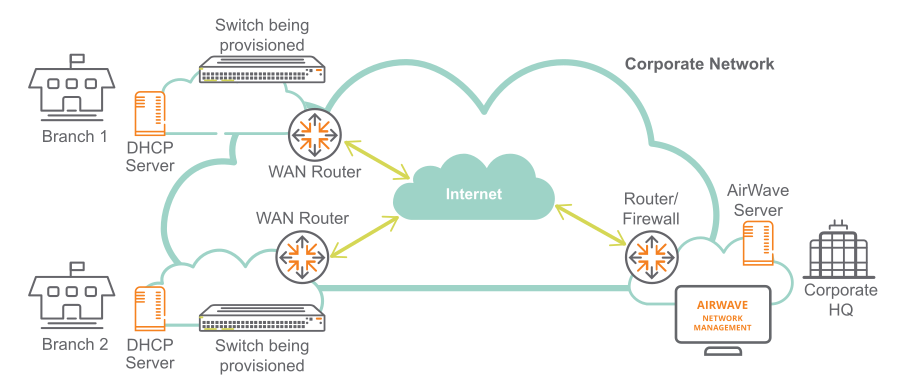ZTP auto-configures your switches as follows:
Procedure
-
The switch boots up with the factory default configuration.
-
The switch sends out a DHCP discovery from data port/OOBM.
IPv4:
The preferred configuration method uses DHCP option 43 value as a string to parse AirWave configuration. Switch expects a DHCP option 60 with value
ArubaInstantAP along with DHCP option 43 to parse AirWave details.
The alternative configuration method supports both encapsulated values from option 43 and direct value from option 43. Encapsulated vendor-specific sub options, with suboption code 146 is for AirWave details.
NOTE: IPv4 DHCP sub option 146 is not supported to configure AMP information through OOBM.
IPv6:
IPv6 uses DHCP option 17 with sub option 100 and vendor class Enterprise ID as 47196.
DHCPv6 based ZTP on OOBM interface,
ipv6 enable and
ipv6 address dhcp full commands are enabled by default on OOBM interface.
-
After the AirWave details are verified and configured, the switch initiates the check-in into the AirWave server using the HTTPS communication. The AirWave configuration must be in the following format:
<Group>:<Topfolder>:<folder1>,<AMP IP >,<shared secret>
-
From 16.08, if AirWave is reachable through both OOBM and Data VLAN, switch tries to register only with AirWave using OOBM.
-
After a successful registration, AirWave can monitor, configure, and troubleshoot the switches. Refer to
Aruba Networks and AirWave Switch Configuration Guide.
-
Check-in failure retry is done every 60 seconds for 10 retries.
-
If DHCP does not provide AirWave details, the switch connects to Activate (Activate ZTP starts) for AirWave or Aruba Central details. If the DHCP options are not configured for AirWave, the switch is left in its default state for manual configuration.

In the preceding illustration, the workflow is as follows:
The switches being provisioned in the branches are booted obtaining the IP address from the DHCP server.
The DHCP servers provide information about the AirWave server in the Corporate Head Quarters.
The switches connect to the AirWave server through the Corporate Network (MPLS VPN or equivalent).
The AirWave server pushes the configuration to the switches based on the AirWave folder, switch model, and branch location.
An optional IPsec tunnel can be established between the branches and the Corporate HQ to secure the management traffic. For more information, refer the
Activate-based ZTP with AirWave.
NOTE: If IPsec tunnel is required for AirWave, the switch requires Aruba Mobility Controller IP address, which is provided through ZTP with DHCP Option 138 (CAPWAP).
